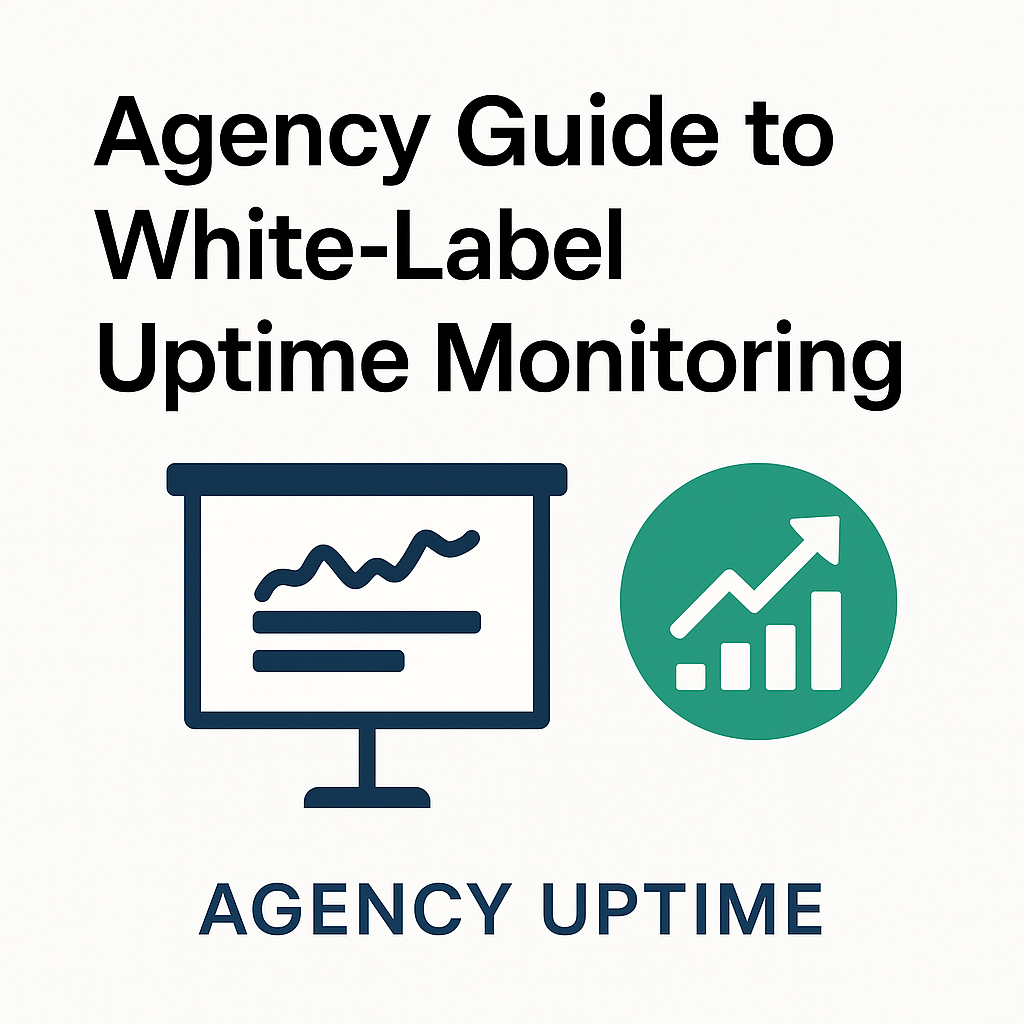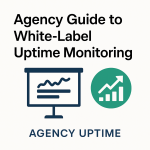Agency Guide to White-Label Uptime Monitoring
Executive Summary
Website uptime monitoring has evolved from a technical necessity to a strategic service offering for digital agencies. This guide explores how agencies can transform uptime monitoring from an operational cost center into a profitable revenue stream through white-label solutions, with a particular focus on AI-powered diagnostics that enable premium positioning and enhanced client value.
Understanding the Uptime Monitoring Market
Traditional Market Structure
Direct-to-Consumer Model:
- Clients purchase monitoring directly from providers (Pingdom, UptimeRobot, StatusCake)
- Pricing: $7-18 per site per month
- Limited customization and branding options
- No agency involvement in the value chain
Market Inefficiency:
- Infrastructure costs are significantly lower than consumer pricing
- Agencies often reimburse clients or absorb monitoring costs
- No revenue generation from essential service requirement
- Missed opportunity for technical service differentiation
White-Label Opportunity
Business Model Transformation:
- Agencies purchase monitoring at wholesale rates
- Resell under agency branding at market rates
- Transform cost center into a profit center
- Strengthen client relationships through a comprehensive service offering
Why Agencies Need White-Label Monitoring
Client Expectations and Requirements
Technical Service Standards:
- Clients expect professional monitoring as part of web services
- Uptime guarantees are increasingly common in service agreements
- Proactive issue detection is essential for maintaining client relationships
- Technical credibility is enhanced through comprehensive monitoring capabilities
Revenue Generation Opportunities
Service Integration Benefits:
- Monitor websites as part of ongoing maintenance contracts
- Offer monitoring as a standalone premium service
- Create recurring revenue streams beyond project work
- Differentiate from competitors offering basic services
Operational Advantages
Client Relationship Management:
- Position agency as a technical consultant rather than a vendor
- Proactive communication about site issues
- Enhanced service level agreement compliance
- Reduced emergency support requests through early detection
Traditional Monitoring Limitations for Agencies
Cost Structure Challenges
Economic Barriers:
- High per-site costs make resale economically difficult
- Limited profit margins when marking up existing services
- Volume discounts are typically unavailable for smaller agencies
- There is no differentiation from direct-purchase options
Branding and Customization Restrictions
Service Integration Problems:
- Generic alerts that don’t match agency branding
- Limited customization of reporting and notifications
- No white-label dashboard options
- Clients are aware they could purchase directly
Technical Limitations
Service Delivery Constraints:
- Basic alerting without diagnostic context
- Limited integration with agency workflows
- No value-added features for premium positioning
- Reactive rather than proactive service model
AI-Powered Monitoring: The Game Changer
Diagnostic Intelligence Revolution
Traditional Alert:
Subject: Site Down Alert
Your website example.com is down (HTTP 522 error)
Status: Offline since 2:34 PM
AI-Enhanced Alert:
Subject: Site Issue Diagnosed - Server Connectivity Problem
Your website example.com is experiencing a Cloudflare 522 error, which indicates your origin server is not responding. This typically means server overload or connectivity issues between Cloudflare and your hosting provider.
Recommended Actions:
1. Check server resource usage
2. Verify hosting provider status
3. Contact hosting support if issue persists
Technical Details: Response timeout after 30 seconds, DNS resolution successful, SSL certificate valid.
Value Proposition Transformation
Agency Positioning Change:
- From: “We monitor your website”
- To: “We provide intelligent diagnostics that explain problems and guide solutions”
Client Conversation Evolution:
- Basic monitoring: Price-sensitive commodity discussion
- AI diagnostics: Value-based technical consultation
- Result: Premium pricing acceptance and enhanced agency credibility
Economic Impact for Agencies
Revenue Optimization:
- Traditional monitoring resale: $15-25/site/month
- AI-powered monitoring service: $50-75/site/month
- Profit margin improvement: 2-3x increase in service value
- Client retention enhancement through superior service delivery
White-Label Implementation Strategy
Service Packaging Approach
Monitoring as Core Service Component:
- Include in website maintenance packages
- Offer as premium add-on service
- Bundle with hosting and technical support
- Positioned as an essential business continuity tool
Client Communication Framework
Proactive Service Delivery:
- Weekly uptime reports with performance insights
- Immediate notifications with AI-powered explanations
- Monthly technical consultations based on monitoring data
- Quarterly performance reviews and optimization recommendations
Pricing Strategy Development
Value-Based Pricing Model:
- Cost: $99/month for 100 sites with AI diagnostics
- Resale strategy: $50-75 per site based on service level
- Break-even: 2 client sites
- Profit scaling: 84-92% margins at 10-20 sites
Technical Implementation Considerations
Platform Requirements
Essential Features for Agency Use:
- Complete white-label branding capabilities
- Custom domain and email notifications
- API access for workflow integration
- Multi-user access with role-based permissions
- Branded PDF reporting for client presentations
Integration Capabilities
Workflow Optimization:
- CRM integration for client management
- Project management system connectivity
- Automated reporting and client communication
- Support ticket system integration for issue-tracking
Scalability Planning
Growth Management:
- Monitoring capacity that scales with client base
- Consistent service quality across client portfolio
- Automated processes for onboarding new sites
- Performance monitoring to maintain service standards
Business Model Economics
Unit Economics Analysis
Cost Structure:
- Platform cost: $99/month (up to 100 sites)
- Additional capacity: Scales with client growth
- Support and management: Minimal ongoing costs
- AI diagnostics: Included in platform pricing
Revenue Potential:
- 10 clients at $50/month: $500 revenue, $99 cost = $401 profit (80% margin)
- 20 clients at $50/month: $1,000 revenue, $99 cost = $901 profit (90% margin)
- 50 clients at $50/month: $2,500 revenue, $99 cost = $2,401 profit (96% margin)
Competitive Advantages
Market Positioning:
- 80-90% cost advantage over traditional monitoring
- AI diagnostics unavailable from direct competitors
- Agency-specific features and workflow integration
- Premium service delivery at competitive costs
Client Acquisition and Retention
Sales Conversation Framework
Problem Identification:
- “How do you currently monitor your website uptime?”
- “What happens when your site goes down and you don’t know why?”
- “How much revenue do you lose during unexpected downtime?”
Solution Presentation:
- Demonstrate AI diagnostic capabilities
- Show branded reporting and alert examples
- Explain proactive vs. reactive monitoring approaches
- Present case studies of improved uptime and faster resolution
Service Differentiation
Unique Value Propositions:
- Only monitoring service that explains what’s wrong and how to fix it
- Proactive technical consulting based on monitoring data
- Agency-branded professional service delivery
- Premium diagnostics at competitive pricing
Client Success Metrics
Performance Indicators:
- Uptime percentage improvements
- Faster issue resolution times
- Reduced emergency support requests
- Enhanced client satisfaction scores
- Increased service contract renewals
Implementation Roadmap
Phase 1: Service Development (Month 1)
Foundation Building:
- Select white-label monitoring platform
- Configure branding and notification systems
- Develop client onboarding processes
- Create service documentation and pricing
Phase 2: Pilot Program (Months 2-3)
Market Testing:
- Launch with 3-5 existing clients
- Refine service delivery processes
- Gather client feedback and testimonials
- Optimize pricing and service packages
Phase 3: Scale and Growth (Months 4-6)
Market Expansion:
- Promote monitoring services to existing client base
- Incorporate into new client proposals
- Develop referral and upselling programs
- Track performance metrics and optimize operations
Phase 4: Optimization and Expansion (Months 7-12)
Service Enhancement:
- Add advanced features and integrations
- Develop specialized monitoring packages
- Explore adjacent service opportunities
- Build monitoring into the core agency value proposition
Risk Management and Mitigation
Service Delivery Risks
Quality Assurance:
- Monitor platform reliability and performance
- Maintain backup communication systems
- Develop client communication protocols for service issues
- Regular testing of alerting and diagnostic systems
Client Relationship Management
Expectation Setting:
- Clear service level agreements
- Transparent communication about monitoring limitations
- Regular service reviews and performance reporting
- Proactive client education about monitoring value
Competitive Response Preparation
Market Position Defense:
- Emphasize AI diagnostic differentiation
- Build strong client relationships and switching costs
- Continuous service improvement and feature development
- Thought leadership in technical monitoring space
Success Metrics and KPIs
Financial Performance
Revenue Metrics:
- Monthly recurring revenue from monitoring services
- Average revenue per monitoring client
- Profit margins on monitoring service delivery
- Client lifetime value, including monitoring services
Operational Excellence
Service Quality Indicators:
- Average uptime across client portfolio
- Time to issue detection and resolution
- Client satisfaction scores for monitoring services
- Reduction in emergency support requests
Strategic Growth
Business Development Metrics:
- Percentage of clients using monitoring services
- Monitoring service attachment rate to new clients
- Referrals generated from monitoring service quality
- Expansion into adjacent technical services
Ready to Transform Your Agency’s Monitoring Services?
White-label uptime monitoring represents a significant opportunity for digital agencies to transform an operational necessity into a strategic revenue driver. The emergence of AI-powered diagnostics creates unprecedented differentiation opportunities, enabling agencies to position themselves as technical consultants rather than merely providing basic services.
The economic fundamentals are compelling: high-margin recurring revenue, enhanced client relationships, and competitive differentiation through superior technology. Agencies that implement comprehensive white-label monitoring services can expect to see immediate improvements in client satisfaction, service margins, and technical credibility.
The key to success lies in selecting the right platform partner, implementing comprehensive service delivery processes, and positioning monitoring as an essential component of professional web services rather than an optional add-on.
Don’t let another month pass, watching competitors eat into your margins while you absorb monitoring costs. AU’s white-label monitoring platform delivers everything outlined in this guide: AI-powered diagnostics that command premium pricing, complete branding customization, and the scalable economics that transform monitoring from a cost center into your most profitable service line.
See AU in action with a personalized demo. We’ll show you exactly how agencies are generating 84-92% profit margins while delivering monitoring services that clients can’t get anywhere else. Book your demo at au.com/demo and discover why smart agencies are making the switch to intelligent monitoring.


